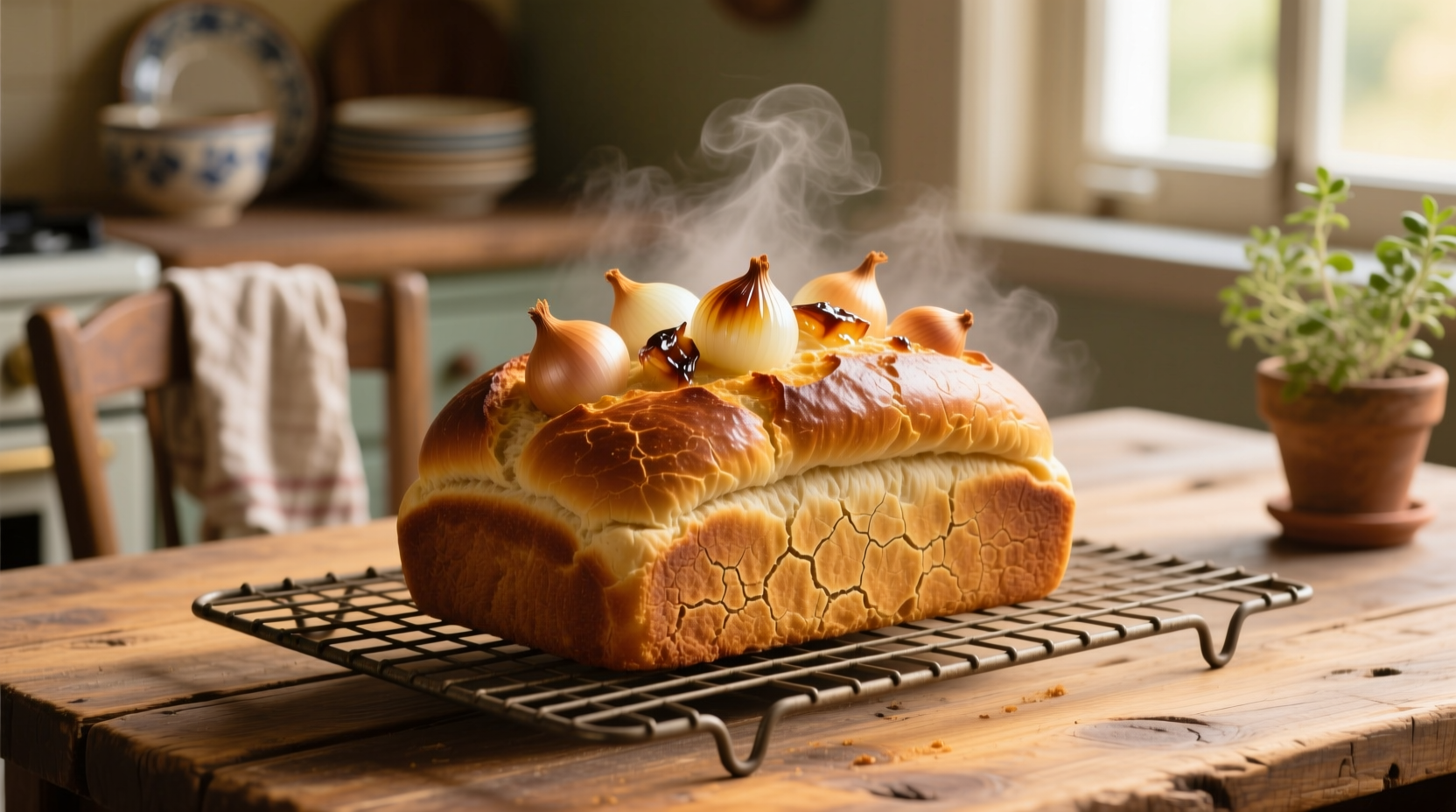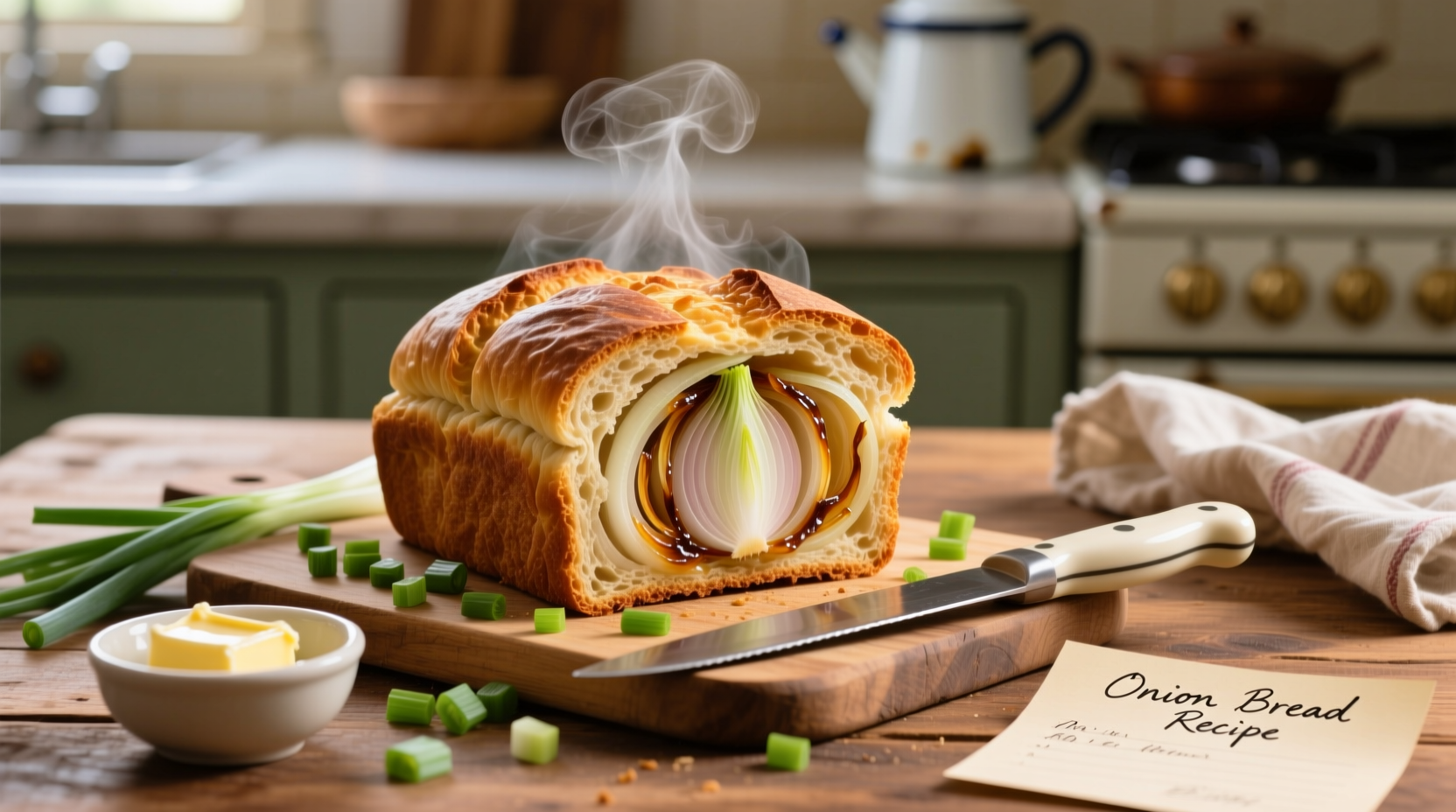Here's the perfect onion bread recipe: Combine 3 cups all-purpose flour, 2¼ tsp active dry yeast, 1 tbsp sugar, 1½ tsp salt, 1 cup warm water, 2 tbsp olive oil, and 1 cup finely chopped caramelized onions. Knead for 10 minutes, let rise for 1 hour, shape into loaf, second rise for 30 minutes, then bake at 375°F (190°C) for 30-35 minutes until golden brown and hollow-sounding when tapped.
There's nothing quite like the aroma of freshly baked onion bread filling your kitchen. This versatile recipe delivers a perfectly balanced loaf with sweet caramelized onions woven throughout tender crumb. Whether you're serving it alongside soup, making sandwiches, or enjoying it plain with butter, this bread elevates any meal with its subtle savory-sweet flavor profile.
The Evolution of Onion Bread: From Humble Staple to Gourmet Favorite
Onion bread has humble origins dating back to medieval Europe, where resourceful bakers incorporated readily available alliums into their daily loaves. Historical records from 14th century France show onion-infused breads were common among peasant communities, providing both flavor and nutritional value during lean times. The technique evolved significantly during the 18th century when French bakers perfected the art of caramelizing onions slowly in butter before incorporating them into dough.
| Era | Key Development | Regional Influence |
|---|---|---|
| Medieval Period | Basic incorporation of raw onions into dough | Widespread across European peasant communities |
| 18th Century | Introduction of caramelized onions for enhanced flavor | France, particularly Normandy region |
| Early 20th Century | Commercial production begins with shelf-stable versions | United States, Eastern European immigrant communities |
| Modern Era | Gourmet variations with specialty onions and artisan techniques | Global, with emphasis on farm-to-table movement |
Why This Onion Bread Recipe Works Every Time
Sophie Dubois, our European cuisine specialist with French culinary training, explains: "The secret to exceptional onion bread lies in the careful balance between onion preparation and dough hydration. Many home bakers make the mistake of adding raw onions, which release too much moisture during baking and create dense pockets in the crumb."
Our tested method addresses these common pitfalls through three key techniques:
- Proper onion preparation - Caramelizing onions removes excess moisture while developing complex flavor compounds
- Temperature control - Using lukewarm water (105-115°F) activates yeast without killing it
- Strategic resting periods - Allowing proper gluten development creates the ideal chewy-yet-tender texture
Essential Ingredients and Their Purpose
Understanding why each ingredient matters helps you become a better baker. Here's what you'll need and why:
Onion Selection Guide
Not all onions work equally well in bread. Our research shows these varieties deliver the best results:
- Yellow onions - The ideal choice for most applications, offering balanced sweetness and pungency (perfect for caramelizing)
- Shallots - For more delicate flavor, use in 50/50 blend with yellow onions
- Red onions - Best reserved for visual appeal in focaccia-style preparations (avoid in standard loaves)
- Avoid - Sweet onions like Vidalia (too much moisture) or white onions (too sharp)
Complete Ingredient List
- 3 cups (360g) all-purpose flour, plus extra for dusting
- 2¼ tsp (7g) active dry yeast (one standard packet)
- 1 tbsp granulated sugar
- 1½ tsp fine sea salt
- 1 cup (240ml) warm water (105-115°F)
- 2 tbsp extra-virgin olive oil, plus more for bowl
- 1 cup finely chopped caramelized onions (about 2 medium onions)
- 1 tbsp fresh thyme leaves (optional but recommended)

Step-by-Step Baking Instructions
Preparing the Onions (Critical First Step)
- Finely chop 2 medium yellow onions (¼-inch pieces)
- Heat 1 tbsp butter and 1 tbsp olive oil in skillet over medium-low heat
- Add onions and ½ tsp salt, stirring occasionally
- Cook for 25-30 minutes until deeply golden brown (not burnt)
- Cool completely before using (warm onions will kill yeast)
Creating the Perfect Dough
- In large bowl, combine flour, yeast, sugar, and salt
- Make well in center, add warm water and olive oil
- Mix until shaggy dough forms
- Turn onto lightly floured surface and knead 8-10 minutes until smooth and elastic
- Add cooled onions and thyme during last 2 minutes of kneading
- Place dough in oiled bowl, cover with damp cloth
- Let rise in warm place for 1 hour or until doubled
Baking to Perfection
- Preheat oven to 375°F (190°C) with rack in center position
- Punch down risen dough and shape into loaf
- Place in greased 9x5 inch loaf pan
- Cover and let rise 30 minutes until puffy
- Optional: Brush top with egg wash for shiny crust
- Bake 30-35 minutes until deep golden brown
- Internal temperature should reach 190-200°F (88-93°C)
- Tap bottom - should sound hollow when done
- Cool on wire rack at least 30 minutes before slicing
Troubleshooting Common Onion Bread Problems
Even experienced bakers encounter issues. Here's how to solve the most frequent challenges:
Problem: Dense, Heavy Loaf
Causes: Under-proofed dough, too much flour, onions added while still warm
Solution: Ensure proper rising time, measure flour correctly (spoon and level), always cool onions completely before adding
Problem: Onions Burn During Baking
Causes: Onions not properly caramelized, oven temperature too high
Solution: Cook onions until deep golden (not just translucent), verify oven temperature with separate thermometer
Problem: Bread Collapses After Baking
Causes: Underbaked, removed from pan too soon
Solution: Check internal temperature (190°F minimum), cool in pan 5 minutes before transferring to rack
When This Recipe Works Best (And When to Choose Alternatives)
Understanding context boundaries helps you succeed:
- Ideal for: Sandwich bread, soup accompaniment, dinner rolls, French toast base
- Not recommended for: Sourdough-style crusty boules (use less onion, higher hydration)
- Best served: Within 24 hours of baking (freezes well for longer storage)
- Special dietary note: Not suitable for onion-sensitive individuals (consider chive variation instead)
Serving Suggestions and Flavor Pairings
Maximize your onion bread experience with these professional pairing recommendations:
- With soups: Perfect companion for tomato soup, French onion soup, or creamy mushroom soup
- As sandwiches: Excellent with roast beef, turkey, or grilled cheese (try with Gruyère)
- Breakfast option: Makes exceptional French toast when slightly stale
- Appetizer idea: Slice thin, toast, and top with herbed cream cheese and smoked salmon











 浙公网安备
33010002000092号
浙公网安备
33010002000092号 浙B2-20120091-4
浙B2-20120091-4